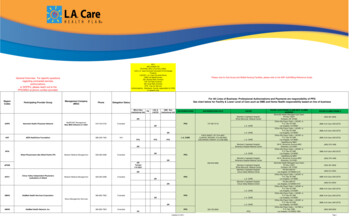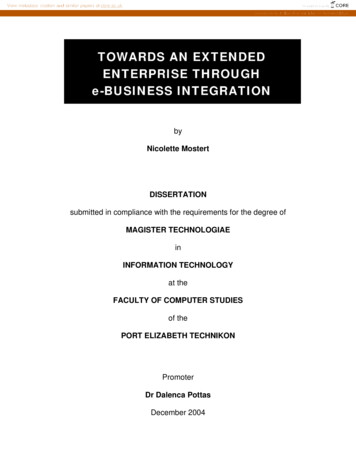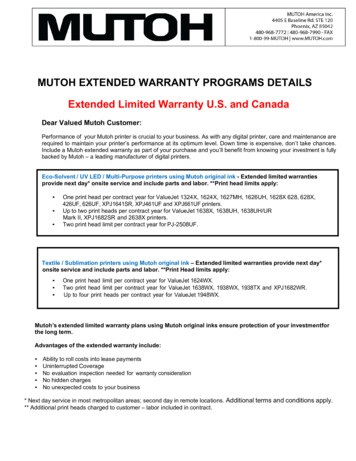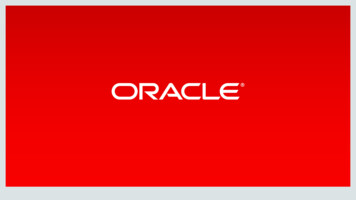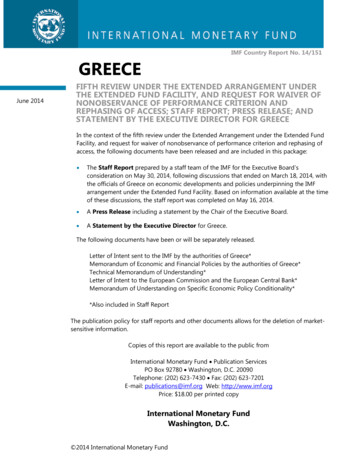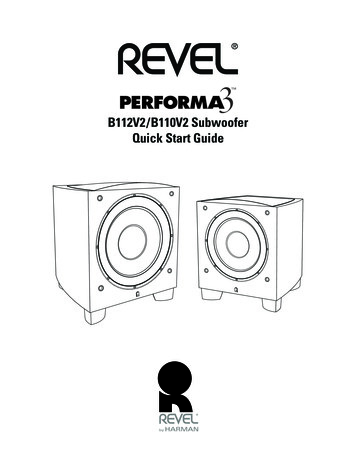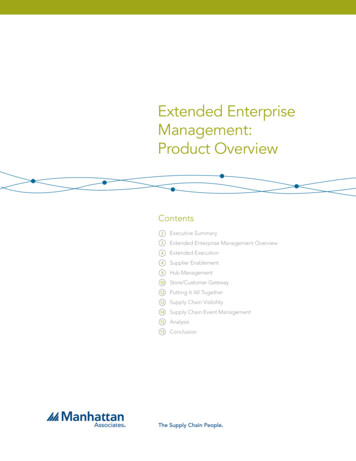
Transcription
Extended EnterpriseManagement:Product OverviewContents2Executive Summary3Extended Enterprise Management Overview4Extended Execution4Supplier Enablement9Hub Management10Store/Customer Gateway12Putting It All Together12Supply Chain Visibility14Supply Chain Event Management15Analysis15Conclusion
Executive SummaryToday’s supply chains continue to grow in complexityorder to optimize the supply chain ecosystem, a heightenedacross several facets. An increasing number of retailers andlevel of collaboration and information sharing is requireddistributors are sourcing goods from outside the country,with all participants in the supply chain – suppliers, freightwhich lengthens lead times and increases the variabilityforwarders, brokers, hubs, carriers, distribution centersof deliveries. While providing significant cost advantages,and customers.often these suppliers lack the ability to communicatedetailed order status information easily. Similarly, logisticsservice providers often are unable to convey detailed, accurate, and timely order status as goods move in and outof their hubs. And finally, carriers used to transport goodssometimes struggle to convey real time shipment status totheir intended delivery destinations.Extended Enterprise Management provides theoverarching visibility and event managementcapabilities required to align all trading partnersup and down the supply chain.Manhattan Associates offers Extended Enterprise Manage-This uncertainty translates directly into excess inventory,ment, a X-Suite solution or cross-suite combination, whichlabor and transportation costs as businesses seek toconnects you with trading partners to communicate ef-protect themselves from the risks created by their tradingficiently and ensure goods move smoothly to your custom-partners throughout the supply chain. Likewise, due toers at minimum cost. Extended Enterprise Managementtheir inability to gain visibility into the current status ofprovides the overarching visibility and event managementinventory, orders and shipments, many businesses losecapabilities required to align all trading partners up andcritical revenue opportunities, which impacts long termdown the supply chain, while ensuring you have the abilityshareholder value and brand equity.to execute the movement of goods in an optimal manner.In an effort to combat these challenges, many industryleaders are now looking for solutions that help them bettermanage these types of supply chain risks. Ultimately, theirgoal is to leverage better technology and business pro-This closed loop approach to managing the supply chainecosystem helps to integrate and align the holistic supplychain while completing the execution cycle, all within asingle solution.cesses to optimize their holistic supply chain ecosystem. InExecutive Summary2
Extended Enterprise Management OverviewManhattan Associates’ Extended Enterprise ManagementA summary of each of the integrated platform applications(EEM) suite of solutions provides extended execution, eventand components of Extended Enterprise Management ismanagement, and visibility capabilities across a company’sbelow.global supply chain. EEM integrates with existing ERP andlegacy applications to communicate with trading partnersefficiently and ensure goods move smoothly through yoursupply chain at minimum cost. EEM’s extended executioncomponents such as Supplier Enablement and Hub Man- Supplier Enablement: Extend powerful supply chaincapabilities to your suppliers to manage order fulfillment and automate communications all via a centralized browser-based solution.agement are designed to help provide tactical execution Hub Management: Enable hubs and 3PL providerssolutions to address the needs of specific trading partnerto provide instant visibility of orders, shipments, andtypes. For example, Supplier Enablement provides facto-inventory. Streamline transport and inventory by man-ries the ability to create case or pallet labels and electronicaging partner-to-partner shipping and enable hubs toASNs via a web portal, greatly improving inventory accu-complete direct fulfillment.racy and receiving productivity. The Supply Chain Visibility Logistics Gateway: Acknowledge order ready-to-shipand Supply Chain Event Management applications provideto initiate transportation optimization and share criti-a single, consistent view of your entire global supply chaincal data in real-time to keep all your transportationallowing key resources to monitor progress and to receivepartners working together to eliminate empty milesproactive alerts for issues before they create problems.and wasted fuel by filling every truck.These applications can provide rapid business improvementas well as provide a continuous improvement platform toenable supply chain transformation with powerful resultsand strategic corporate benefits. Store/Customer Gateway: Let customers and storestrack and receive their orders and shipments via onecentralized portal and provide receipt of delivery andinventory on-hand. Supply Chain Visibility: See a single, consistent,real-time view of your entire global supply chain forgreater inventory control, to promote optimal fulfillment channels, and to reduce cycle time variability tolower safety stock levels. Supply Chain Event Management: Track and monitorsupply chain events in real time and respond immediately based on alerts to critical exception events, whichmay threaten your ability to meet customer demand.Extended Enterprise Management Overview3
extended enterprise management:creating extensibility byenabling trading partnersVISIBILITYMA NA GEMENTEVENTPURCHASEORDERSC ARRIERS3PL SSUPPLIER SCUS TOMER S/S TORESRECEIVINGREADY SASNSEXTENDEDENTERPRISEGATEWAYPFIOOLMTLMDMS U P P LY CHAIN PROCESS PLATFORMYOUREISEN TERPRExtended Enterprise Management: Managing Product from Source-to-ConsumptionExtended ExecutionSupplier Enablementpurchase a new system and the infrastructure to support it.)In today’s manufacturing environment, supplier networksSupplier Enablement extends execution capabilities tocan be extremely complex. A company must have the flex-suppliers and factories. There are five primary areas ofibility to work with:focus for Supplier Enablement: Requisition Management, Domestic and foreign suppliers (language barriers,currency issues, time zones) Varying levels of technology (fully automated systems,paper-based processes, high-speed Internet, dial up,EDI and fax) Multiple tiers of manufacturing.EEM is designed to integrate with these varied suppliersthrough EDI, XML, Flat file, and other formats that leverageexisting processes and technologies. EEM also allows for‘system-to-user’ integration, which provides internet browserscreens to facilitate integration where no system exists. Thereason for having such a flexible system is so that you canwork with various global trading partners without forcingthem to make significant technology investments and busi-PO Management, Inspections, Fulfillment & Shipping, andChargebacks.1. Requisition ManagementPrior to Purchase Order creation, some companies utilize arequisition or commit process. Requisitions have a separate set of user transactions and role based permissions.Companies can negotiate order quantities, dates, and moreonline. Once details of the requisition are agreed uponbetween the supplier and the buyer, the requisition can beused to create a purchase order(s). Typically the purchaseorder is created in an ERP or purchase order managementsystem. The requisition process is also monitored by thatsystem, and notifications are generated if any exceptions inthe process are detected.ness process changes (e.g., do not ask a manual factory toExtended Execution4
Benefits of requisition management include: Improved communication and documentation ofnegotiations with suppliers Reduce COGS from economies of scale by identifying consolidation opportunities of purchase orders toreduce item cost basis Manufacturer/supplier-based visibility of “pre”- purchase orders for more efficient planning to meetfuture demand Reduced errors by monitoring the requisition process.Requisition Listing2. Purchase Order ManagementIn many organizations, particularly those with offshoremanufacturing and an international supplier base, theprocess of managing the lifecycle of a purchase order (PO) isboth electronic and browser-based updates are made. Withthe supplier always manufacturing against the current PO,the margin for error is greatly reduced and the PO negotiation effort is simplified.manual. Although created electronically on an ERP or orderBeyond error reduction and simplified PO negotiation pro-management system, POs tend to be phoned, faxed, andcess, benefits of PO management also include:emailed to suppliers. Acceptances, updates, and cancellations are similarly manual. For many grocers, retailers, andother companies that generate thousands of POs per year, Increased upstream visibility into the manufacturingprocess, resulting in:o More predictable cycle-timenity for error is significant. Factor in language barriers, ando Lower safety stock levelsthe need for electronic integration is even more critical.o Lower stock-outsPO management within EEM is the systematic managemento Enabling available–to-promise capabilitiesof executing the purchasing process. As POs are issued, Reduced clerical workload through the automation ofdata exchange and entryexcluding multiple iterations of a single order, the opportu-they are downloaded into EEM. EEM routes the order tothe appropriate supplier (and service providers, if required),to either acknowledge an order electronically with their Reduced transportation costs, based on more accurateinventory information and fewer unplanned modalchangesown systems, or accept/update the order online via EEM. Increased accuracy in planning of inventory levelsproviding email notification as necessary. Suppliers are ableAs changes are made, either by the buyer or manufacturer, Increased supplier accountability.Extended Execution5
Purchase Order ListPurchase Order Details3. Inspections / Quality AssuranceAs greater PO management capabilities increase orderaccuracy, Inspection (or Quality Assurance) featuresprovide users the confidence to implement lower safetystock levels and acknowledge available-to-promise dates.EEM users can request new inspections for quality checksvia the Inspection function. By creating new inspectiontasks in EEM, orders and/or cases can be flagged via a“sample” group and inspected for case and unit quantityBenefits of Inspections include: Increased order accuracy Trading partner accountability Reduced manual order reconciliation work Early visibility to downstream order deliveryinconsistencies Reduced returns transportation spend.defects for a respective order. Companies are able toview inspection results and have tangible information onthe status and accuracy of their order.Extended Execution6
Inspections for a purchase order4. Fulfillment and ShippingIn many warehousing environments, the availability of caseand pallet-level ASNs are limited. The benefits of ASNs andstandardized labels are many, including: One scan receipts for faster receiving Automated receiving enabled (via conveyor) Cross docking Flow-through distribution Direct ship programs Error reduction Improved quality Inventory accuracy Inventory accountability.Unfortunately, many suppliers are either unable to providesuch information and labels, employ a costly 3rd party, or doso in a manual, mistake-prone process.EEM Supplier Enablement provides ASN-generation capabilities to trading partners. Upon accepting the purchaseorder, a variety of packing functions, configurable by thehost, are available to the supplier to create electronic ASNsand/or shipping labels. These functions can be as ‘loose’ asidentifying the SKUs and quantities in a packing container,using standard casepack for minimal UI interaction packing,or as strict as requiring each unit’s bar code to be scanned.The net result of this process is a very granular level of dataincluding the following: Purchase Order Shipment LPN (case or pallet) SKU Quantity SKU attributes (e.g., country of origin, lot,expiration date.) Bill of Lading (BOL).This data is subsequently uploaded to the warehouse management system and merchandising/planning systems toachieve the benefits described above.Lastly, EEM provides the supplier the ability to print accurate, standard shipping documents, such as manifests, packlists, and bills of lading. These documents are generatedusing the data captured during fulfillment and therefore, theprocess is accurate and automated.Extended Execution7
Shipment details, including ASN and BOL numbersCase and Pallet level LPNs for a shipmentPacking List ExampleExtended Execution8
5. ChargebacksIt is common for companies unknowingly to ignore inefficiencies in their supply chain at the point of receipt, which cancost them thousands of dollars. Many companies continually receive inaccurate or untimely shipments such as lateshipments received, order underfilled, or order overfilled.The charges can be created, edited, and cancelled, andconfigured for visibility and acceptance of the supplier.Charge change history can be viewed in the system, andevents and notifications are generated for the majorprocessing milestones.The benefits of chargebacks include:While there are many key performance indicators (KPI’s) Increased order accuracyto measure supplier compliance, many companies do not Increased order fill rateshave the construct to chargeback costs to the supplier for Increased on-time deliveriespoor service and execution. EEM provides the ability tocreate and manage chargebacks to suppliers. This featureis used to create claims for events such as damaged products, non-compliance, demurrage, and more. Chargebacksare associated with PO shipments and are either system or Increased shipment accuracy Increased supplier accountability Reduced supply chain “operating” costs Demurrage cost reallocation to trading partner.manually generated.Chargebacks for a purchase orderHub ManagementAs a result, there is:With increased outsourcing of both manufacturing and Lack of visibility to receipts and shipments at hubsdistribution both domestically and globally, hubs play a Inability to create ASNs of shipments leaving the hubsmore integral role in supply chains than ever before. Hubs Limited ability to print shipping labels, documentationfrequently support consolidation in transporting multiplesmall shipments from suppliers. They also help supportthe outbound distribution process to customers or stores.Companies are increasingly searching for transportationproviders to offer more value added services at thesehubs, or even bypass warehouses altogether, and ship di- Inability to re-direct partial or full order direct tocustomer No capability to substitute cases via a PO split for moredynamic order fulfillment No integration to back-end systems of customers.rectly to customers via these hubs. Unfortunately, many ofRegardless of the degree of automation at suppliers andthese facilities are small and historically have not been ablewarehouses, the lack of these capabilities at hubs andto justify the investment in automation and systems.service providers will continue to limit the efficiencies of theoverall supply chain.Hub Management9
ASN’sSUPPLIERASN’sHUBASN’sWAREHOUSEEEM Hub Management solves these problems by extending execution capabilities to hubs. Through the simple useof a PC, an Internet connection, and a scanner, hubs canautomate such processes as receiving, cross docking, andload building,to help address the problems stated above.Additionally, Hub Management can support direct shipprocesses, allowing companies to consolidate shipments ata hub and ship directly to stores and customers, bypassingwarehouses altogether. Through integration with backendsystems, Logistics Hub Management not only facilitates theexecution of this process, but also provides sophisticatedASN’sHUBCUSTOMERS/STORESBenefits of Logistics Hub Management include: More accurate receiving processes through standardized labels and shipping documentation Reduced inventory levels and order cycle time throughinventory visibility Reduced transportation costs and improved customerservice through drop shipment programs Reduced transportation costs, inventory carrying costs,labor costs, and time-to-customer/store by direct-tostore (DSD) shipments from Hub.functionality not often found.Store/Customer GatewayThe final node in the supply chain for most companies is theend customer -- business partners, corporate-owned stores,consumers, and often times all three. This is the part of thesupply chain that directly affects customer service, changesthe customer experience, and affects future sales. There arethree main areas of Extended Enterprise Management thatrelates to Store/Customer Gateway:o Order/Inventory Visibility In today’s business environment, real-time visibility is notwhat other products might be available. Comprehensiverules are available to govern visibility into data that mightbe outside the normal inventory levels. For instance, ifinventory falls below a certain tolerance, this can behidden from customers in order to maintain confidencethat shipping requirements can be met. As with suppliers, each customer has a varying degreeof sophistication. For the smaller customer, browseraccess will be a welcome addition. For the largercustomer with hundreds or thousands of suppliers, abrowser-based solution would be an inconvenience,only crucial to an enterprise, but to its customers as well.as the need to access hundreds of different Web sites,Historically, providing customer order status informa-each with its own user ID and password, becomes ation has been the job of customer service departments.costly burden. For these customers, EEM can provideThrough EEM Store/Customer Gateway, this process canreal-time order status updates via XML or other formats,be fully automated, creating ‘self service’ applications forto be integrated into the customer systems for a unifiedcustomers. EEM provides a Web-based order inquiryview of data across their suppliers.with complete company-based security, only grantingcustomers visibilityto the status of their orders. WhatBenefits of these types of applications include:makes this inquiry different from others is that it fully Reduced need for customer service departmentsand seamlessly integrates into the WMS, ERP, and other Improved customer service departments by offeringCSRs a single source for data across multiple, disparatesystemsOMS systems, providing a granular level of information,down to the case, SKU, and attribute level (e.g., countryof origin and expiration date). Furthermore, customerscan view current inventory information to help query 24/7 access to real-time dataStore/Customer Gateway10
Inventory view for a specific Itemo Web-Based Order Entry For many companies, EDI has become the method ofo Receipt Confirmation The final step in the order cycle is receiving. For mostchoice for placing and accepting orders. EDI bringscompanies, once the product leaves the warehouse,along the many cost savings associated with automat-the cycle is considered complete. However, this is aing a process. It also highlights the higher costs offallacy that can result in lower customer satisfaction andtaking orders from those customers who are unableinaccurate company metrics. EEM provides customersto place orders via EDI. Typically, these are smallerand stores the ability to confirm receipts using the samecompanies who depend on manual processes such asportal provided for order visibility and order entry. Atphone, fax, and email. Many companies are startingthe time of receipt, customers can indicate the exactto conclude that these types of customers do not carryproduct received and provide feedback to the supplierthe same profitability as larger customers and are plac-as to the quality, timeliness, and service level provided.ing an ultimatum -- start providing EDI orders or findWhile a seemingly simple action, receipt confirmationanother vendor.by the customer is critical for obtaining true end-to-end EEM Store/Customer Gateway presents an alternativevisibility in one’s supply chain. Benefits include:path. Through the same portal that provides order Relevant, timely customer feedbackvisibility, customers are able to place orders. These More accurate metrics on such key processesorders are then processed by EEM and passed directlyto back-end systems (e.g., ERP, OMS or even WMS.) Order cycle timeTo these systems, orders appear no different than ones On-time percentageprocessed using EDI. The benefits of Web-based order Order fill rateentry include: Higher profit margins through automation Improved customer experience and service Lower customer service costs Precise invoicing, based on customer receipts ratherthan shipments Accurate revenue recognition Improved carrier rating (was the carrier servicelevel met?) Increased order intake via additional order entry points.Store/Customer Gateway11
Putting It All TogetherEach of these individual components can provide significantvalue to companies. Tactical solutions such as LogisticsGateway can provide strategic value through deferredcapital expenditure. Supplier Enablement can increaseinventory accuracy and create dramatic financial improvements. The maximum benefit of EEM, however, can betogether, along with functionally robust warehousing andtransportation solutions to create true end-to-end executioncapabilities from supplier to customer. This combinationof solutions is unique to Manhattan Associates because ofits broad and deep functionality. Companies are now ableto reinvent their supply chain and provide a single face forexecution across all nodes in the network.attained only when combining the various componentsSupply Chain VisibilityWith Extended Enterprise Management solutions deployedto provide integration with suppliers, hubs, carriers, andcustomers of all capabilities, companies have unparalleledvisibility into their entire network. From orders to shipmentsto inventory, the most granular level of data is available,down to the country of origin of product in an individualcase, on a particular trailer, in transit from Long Beach toMemphis. In every industry, this level of real-time visibility isvital for achieving supply chain efficiencies.Supply Chain Visibility InventoriesAs the length of supply chains continue to increase, so doesBest in class companies find a way to reduce this lead-timethe need for visibility into the supply chain. In the examplevariability through visibility into their supply chains, giving in-below, goods being sourced in Asia and shipped via oceanventory planners more certainty when planning their orders.have more lead time variability, leaving you with 3 options:On-line maps are pre-integrated to provide an intuitive view Carry more inventory Continue to ship product via Airof global locations along with associated order, inventory,and shipment details by location. Put customer service level at riskSupply Chain Visibility12
Lead Time Variability Often More InventoryHigh-TechBenefits include: Lower inventory levelsRetail/Grocery Faster time–to-market for new products Improved in-stock position Effectively outsource logistics to third parties throughtrading partner management Lower inventory levels Increased inventory turns Reduced order cycle time Decreased order cycle times Improved responsiveness to events Improved on-time delivery Reduced cost of goods sold through drop shipping Reduced expedited costs Improved customer service levels and management ofservice parts Increased warehouse productivity Improved responsiveness to events Reduced inventory loss due to expiration of goods Better trading partner management throughscorecardsConsumer Goods Lower inventory levels Increased inventory turns Improved customer service Improved CSR productivity Increased warehouse productivity Better trading partner management throughscorecards Improved responsiveness to eventsSupply Chain Visibility13
EEM provides a holisitic view of raw materials and finishedOrder Management (DOM) enables you to satisfy demandgoods inventory across the supply chain, including all theusing the full supply pipeline by diverting in-flight inventoryway back to your suppliers’ on-hand. As mentioned above,to where it’s needed most: directly to customers, directly toeven items that are in-transit are visible with EEM, andstores, or to the appropriate distribution center based oncan be dynamically allocated or routed based on chang-real-time inventory positions.ing demand locations. Manhattan Associates’ DistributedSupply Chain Event ManagementThe ability to identify and respond to events can only beachieved by having real-time, accurate data. With ExtendedEnterprise Management, companies can leverage Manhattan Associates’ event management capabilities. Improveyour inventory control, cycle time variability, inventory turns,warehouse productivity, customer satisfaction, and overall Account managers being notified if their key accountshave been receiving exceptional service (either goodor bad) Warehouse supervisors being alerted if waves are running behind schedule or if replenishment issues arise Traffic managers being made aware of transportationissues, trends, etc.efficiency by alerting key personnel of exception events soSupply Chain Event management provides sophisticatedthey can adjust their plans, promotions, and labor sched-tools such as schedules/milestones, escalation, notificationules. Examples include:delays, and address calendars, to manage these events. Buyers receiving alerts if their orders are running late orwill be shortEEM’s exception-based approach ensures that the resourcesaddressing supply chain issues can focus on resolving theproblems, rather than having to find them.Event Management NotificationsSupply Chain Event Management14
AnalysisUltimately, much of the data generated by these systemsis stored in a massive datamart for detailed analysis. Usingthe capabilities of a cutting-edge business intelligencesystem, key performance indicators (KPIs) and predefinedviews are tailored by role to provide key users the historical trend analysis tools needed to manage the business.Examples include: Vendor performance scorecards (on time percentage,volume, seasonality, etc.) Shipping scorecards (weight, volume, dollars by carrier,service, date, etc.) Inventory metrics (percentage by country of origin,average on hand, etc.) Customer service metrics (order fill rate, cycle time, ontime percentage, etc.)Key Performance IndicatorsConclusionWhether you need to increase collaboration, provideproactive management around unplanned supply chainWith Extended Enterprise Management, you can: Manage global collaborative commerce with one centralized solution.disruptions, or facilitate the movement of goods, Extended Increase on-time delivery rate by 10-20%.Enterprise Management can provide a quick return for Reduce warehouse receiving time by 20% to 40%.your organization. By collaborating more effectivelywith partners anywhere in the world, you can ensure thatgoods flow dynamically through the optimal channels to Increase order fill rate by 5% to 15%. Remove 3-5 days of inventory from your supply chain.your customers. Extended Enterprise Management gives Decrease cycle-time variability by 2-4 days.users throughout the extended enterprise – suppliers, hubs, Lower inventory safety stock levels 5-15%.carriers and customers – the ability to share information Reduce overall inventory carrying, transportation andlabor costs.within a single platform.Conclusion15
Manhattan Associates continues to deliver on its 19year heritage of providing global supply chain excellenceto more than 1,200 customers worldwide that considersupply chain optimization core to their strategic marketleadership. The company’s supply chain innovations include:Manhattan SCOPE , a portfolio of software solutionsand technology that leverages a Supply Chain ProcessPlatform to help organizations optimize their supply chainsfrom planning through execution; Manhattan ILS , aportfolio of distribution management and transportationmanagement solutions built on Microsoft .NET technology;and Manhattan Carrier , a suite of supply chain solutionsspecifically addressing the needs of the motor carrierindustry. For more information, please visit www.manh.com.Global Headquarters2300 Windy Ridge ParkwayTenth FloorAtlanta, GA 30339tel 1 770.955.7070fax 1 770.955.0302www.manh.comOffices in:AustraliaChinaFranceIndiaJapanSingaporeThe NetherlandsUnited KingdomUnited StatesCopyright 2008 Manhattan Associates. All rights reserved.
Manhattan Associates offers Extended Enterprise Manage-ment, a X-Suite solution or cross-suite combination, which connects you with trading partners to communicate ef-ficiently and ensure goods move smoothly to your custom-ers at minimum cost. Extended Enterprise Management provides the overarching visibility and event management
